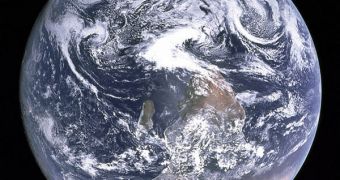At about 4.5 billion years old, one could expect Earth to be a lot calmer than it was in its earliest days, but researchers say that this is not the case. Solidified from a ball of hot lava, the planet is now covered by large amounts of water, and is the only celestial body in the known Universe that is capable of supporting life. Though it still packs some kicks, such as massive eruptions and earthquakes, it is a lot more tranquil than it was in the distant past. Experts say that it will most likely continue to behave erratically for at least several billions of years ahead, LiveScience reports.
One of the things that allowed Earth to support life and to become the wonderful place to live it is today was a cosmic impact. Over the eons, countless impactors have slammed into the planet. The largest one was the space rock that caused the formation of the Moon, but other large ones also struck us. For example, the one that killed off the dinosaurs, the Chicxulub impactor that struck in Mexico, had a significant impact on the planet, causing massive eruptions and earthquakes around the globe.
Another thing that constantly reshapes the planet is the movement of the tectonic plates. They essentially float on top of an ocean of magma, the planet's mantle. These movements are also marked by volcanic activities and tremors, and they cause the surface to constantly change its appearance. The world looked a lot different than it does today some 750 to 500 million years ago, with a giant continent and a giant ocean being the only features. Even today, these motions change the way the Earth behaves. The magnitude-8.8 earthquake that struck Chile on February 27 shifted the planet's figure axis by 3 inches (8 centimeters). The January 12 tremor that struck Haiti also shows that we are still living in a dynamic, ever-changing world.
“Giant impacts have punctuated the history of Earth from its beginnings, and even before that, with the Earth's core probably formed by impacts of large protoplanets colliding together. Our planet was born in violence, and even though the violence has subsided a bit, moderate-sized events still happen now and again,” says Purdue University planetary scientist Jay Melosh. Experts say that we shouldn't believe that we are living on a calm planet. In fact, we may at any point experience another eruption such as the one at Mount Tambora, Indonesia, in 1815. It killed 71,000 people on its own, and caused 1816 to receive the name “The Year Without Summer”. Hundreds of thousands died in the ensuing famine.

 14 DAY TRIAL //
14 DAY TRIAL //